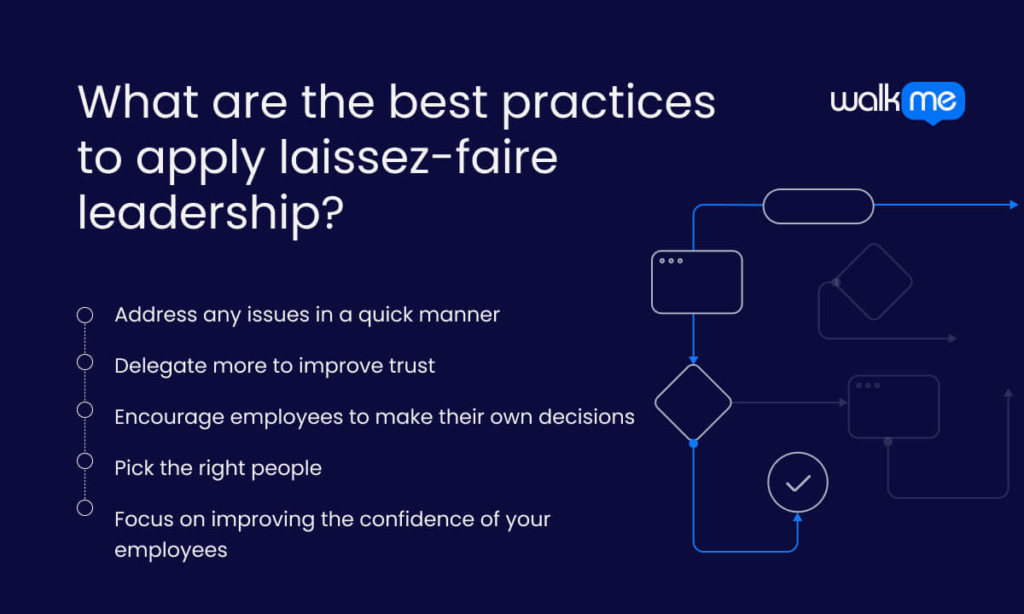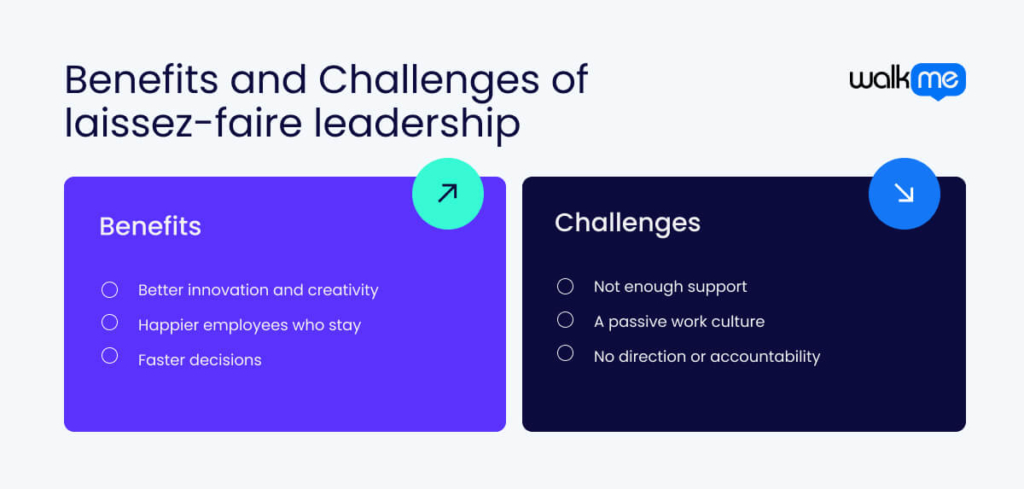Different companies need different ways to succeed. If your business has creative, experienced, and self-motivated employees, laissez-faire leadership might work well. This style lets employees use their skills to make decisions for business transformation and supports more flexible approaches to change management.
This often results in higher employee retention and productivity. ‘Laissez-faire’ is a French term that means ‘let do’ or ‘leave alone.’ It focuses on giving people the freedom to make their own choices.
In this article, we will explain what laissez-faire leadership is and its key traits. We will also show examples of how it works and compare it to other leadership styles. Finally, we will discuss the best practices, pros, and cons.
What is laissez-faire leadership?
Laissez-faire leadership is a hands-off style that gives people the freedom to make their own decisions. Leaders provide resources and tools but stay out of daily tasks.
This style is common in creative fields like advertising or startups. It encourages independent thinking.
The term originated in the 18th and 19th centuries, inspired by economists like Adam Smith, who advocated for minimal interference, believing in an ‘invisible hand’ that guides people’s actions.
How is laissez-faire leadership different from other leadership styles?
Laissez-faire leadership lets employees make all decisions with little supervision. This style works well in creative fields like advertising and research.
Here’s how it differs from other leadership styles:
Autocratic leadership
In autocratic leadership, the leader makes decisions without input from the team and has full control over tasks, unlike laissez-faire. Communication is one-way, and feedback is rare. This style is common in crises or in places like the military and manufacturing.
Democratic leadership
In contrast, with a democratic leadership style, leaders ask for input from the team before deciding. Communication is two-way, and leaders guide discussions. Unlike laissez-faire, both leaders and employees share responsibility. This style works well in team-focused environments.
What are some examples of laissez-faire leaders?
Here are the best examples of laissez-faire leaders to inspire you:
Herbert Hoover
President Herbert Hoover strongly supported laissez-faire economics. He believed in a hands-off approach, thinking the economy would fix itself. This belief made it hard for the U.S. to recover from the Great Depression.
Despite this, Hoover’s leadership led to important projects like the Hoover Dam. The dam helped stop flooding and provided clean energy with water-powered generators.
Andrew Mellon
Andrew Mellon, a 1900s American businessman, used a laissez-faire leadership style. He chose skilled managers and trusted them to grow his business. Mellon started in his father’s bank, and it expanded quickly. He built an empire through delegation and flexible management.
Mellon disagreed with industry rules, tariffs, and taxes. He thought they would limit creativity and innovation. His laissez-faire approach helped him succeed in many areas, including philanthropy, banking, manufacturing, politics, and art collecting.
Warren Buffet
Warren Buffett’s leadership style prevents leaders from interfering in decision-making, giving workers the freedom to run things independently.
Buffett lets his company owners operate without much supervision or monitoring. Most managers use this freedom well by acting like owners. Buffett is known for being very hands-off with his companies. While this approach works for him, it’s not right for every senior manager.
Richard Branson
Richard Branson, the founder of the Virgin Group, is known for his laissez-faire leadership style. He encourages employees to take risks, be entrepreneurial, and follow their passions within the Virgin brand.
The Virgin Group’s many businesses, like music, airlines, and telecommunications, show Branson’s trust in his teams to explore new ideas. His hands-off approach has created a culture of innovation and adaptability. The success of the Virgin brand shows the benefits of giving employees the freedom to make decisions and guide their own projects.
What are the best practices to apply laissez-faire leadership?

Here are the best tips to apply a laissez-faire leadership style:
Address any issues in a quick manner
Laissez-faire leaders can struggle to be seen as the go-to person for advice. It’s important to make sure employees feel they can come to you with any problems. Knowing they can reach out makes them feel more supported in their work.
Being more visible in team channels helps you seem more approachable. Encourage a positive, collaborative environment with open communication and respect. Recognizing accomplishments boosts engagement and productivity.
Don’t wait for employees to bring up issues. Stay aware of what’s happening in your team and the company. This lets you step in and make changes if needed. It shows you are a capable leader, even if you’re not always in control.
Delegate more to improve trust
Some people find it hard to step back in team management. But sometimes, letting go is the best thing you can do. Start by not micromanaging every issue. Be a resource and ask for final approval, but let your team handle things.
After giving your employees more independence, try delegating tasks to show trust. Trust is key in laissez-faire leadership. Leaders believe in their team’s abilities and trust them to make good choices. Encourage your team to take ownership of their work. Give them the freedom to make decisions and trust their judgment. This boosts creativity and innovation.
Even if you’re not directly involved, keep an eye on your team’s performance. Notice how they work together and any challenges they face. Use performance reviews to discuss these observations. You don’t have to act on everything you see, but stay aware. This way, you can step in with the right solution when needed.
Encourage employees to make their own decisions
Laissez-faire leaders should encourage their teams to make decisions and solve problems on their own. This can include employee training to boost confidence and skills for more responsibility.
Leaders should be available for support when needed without limiting employees’ freedom. It’s important to balance giving freedom with being there to help. Set clear goals, processes, and support systems. Make sure employees have the resources and information they need to work independently.
Even if you’re hands-off, stay involved. Regular communication and feedback are key. Check-ins and one-on-ones help keep everyone on track.
Pick the right people
If you want to use laissez-faire leadership, start by choosing the right team. This style works best with experts in their field. Hire talented, motivated, and skilled people who can excel on their own.
Once you have a strong team, it’s easier to step back and let them do their best work. Laissez-faire leadership needs an independent and skilled team. For example, if you have new employees who need a lot of guidance, laissez-faire leadership would not work well.
Even with the right team, you can still help them succeed. As a leader, connect them with training, mentors, and resources. This helps your employees grow and do their best.
Focus on improving the confidence of your employees
A laissez-faire leadership style gives team members more independence. But, they still benefit from some guidance. Regular feedback helps them understand their strengths and areas for improvement. This feedback allows them to work on skills and handle tasks independently while building confidence.
Leaders might offer incentives to keep employees motivated. Incentives can boost autonomy and productivity. They can be small, like food treats, or larger, such as bonuses or extra days off. These extra days could be for annual leave or mental health. Offering incentives supports employee experience and performance.

What are the benefits of laissez-faire leadership?
The main benefits of laissez-faire leadership are:
Better innovation and creativity
Focusing on personal growth and trusting people’s abilities creates space for innovation. It allows them to be creative without fearing failure or its consequences. When mistakes are allowed, and people are trusted to contribute in big ways, creative people can thrive. This benefits the team and the whole company.
By giving team members autonomy and freedom, the laissez-faire style boosts creativity. It encourages innovative thinking. Team members are more likely to come up with unique ideas and solutions when they have room to explore and experiment.
Happier employees who stay
A positive work environment usually lacks a tyrannical boss. This kind of stress is rare in teams led by a laissez-faire leader.
Laissez-faire leaders offer flexibility, creating a low-pressure environment where most people can thrive. They have a relaxed, confident, and easygoing attitude. They don’t get too upset about the bad stuff or too excited about the good stuff. Their goal is to keep a steady energy to maintain stability and peace in the workplace.
Employees are likely to feel more relaxed, and a low-pressure workplace can lead to higher job satisfaction and better employee productivity.
Faster decisions
Laissez-faire leadership encourages accountability at all levels. When employees can do their jobs their way, they feel more responsible for their actions, whether the results are good or bad.
Leaders who use laissez-faire know the importance of hiring the right people. These employees work on decision-making and find their own ways to work.
Employees don’t make decisions alone. They collaborate and discuss projects and goals with each other. Leaders act as consultants or mentors when needed. This allows for faster decision-making since there is no micromanagement. Employees have the freedom to make decisions and solve problems without needing approval.
What are the challenges of implementing laissez-faire leadership?
The main challenges of putting in place laissez-faire leadership are:
Not enough support
Laissez-faire leadership may not work for every team or workplace. Some employees need more guidance and support, and certain industries or situations require a more hands-on approach.
In these cases, leaders need to be flexible. They should use parts of other styles, like authoritarian or democratic leadership. This helps fit the needs of the team. If the team has little experience, laissez-faire leadership can cause problems.
It may hurt their confidence. They might feel they should handle things alone. When they can’t, they may see themselves as failures, even though they aren’t.
A passive work culture
Laissez-faire leadership often means being passive, which can also be a way to avoid real leadership. In these cases, leaders don’t try to motivate their team, recognize their team’s efforts, or get involved with the group.
Even if employees feel confident making decisions, they may still feel neglected. They might think their manager doesn’t care about their work or its results. This attitude can spread to the rest of the team, and as a result, the team may become indifferent to their own work.
No direction or accountability
One downside of a hands-off leadership style is the confusion it can cause. It can also lead to a lack of accountability. Laissez-faire leaders may struggle to give enough support or guidance. This can make the team less efficient. Some leaders use this style to avoid responsibility when things go wrong. They may blame the team for not meeting goals or finishing tasks.
Leaders should balance giving autonomy with offering direction. Regular check-ins are important. Progress updates help team members stay clear on goals and expectations.
Use a laissez-faire leadership approach to grow and innovate at a faster pace
Laissez-faire leadership can be very effective if used wisely. Real-world examples show how this hands-off style can boost a team or cause problems if not handled well. This approach can spark creativity, give employees more control, and make them feel more responsible.
But, it needs careful management to avoid issues like a lack of direction and accountability. The success of laissez-faire leadership depends on the context, industry, and company culture. Leaders must adapt this style to fit their team’s needs and the organization’s goals.
FAQs
A laissez-faire work environment is great for forward-thinking and resourceful people. It also works well for smart, dependable, and confident in their skills. Industries that value innovation can benefit from this leadership style.
Creative and innovative industries like advertising, technology, fashion, and entertainment can benefit from a laissez-faire leadership approach, as it gives employees the freedom to work and create independently.
Laissez-faire leadership is good for early brainstorming or product creation. For production, more direction may be needed. This style struggles with efficiency and productivity. It’s not suited for precision work or high-pressure settings. People who struggle with deadlines may perform poorly without enough guidance.
The key characteristics of laissez-faire leaders are:
- Rely on employees to manage tasks independently
- Intervene only when it’s needed
- Stay updated without direct involvement
- Offer minimal guidance
- Provide employees with plenty of resources and tools
- Give feedback and constructive criticism occasionally
- Take responsibility for the team’s decisions and actions

